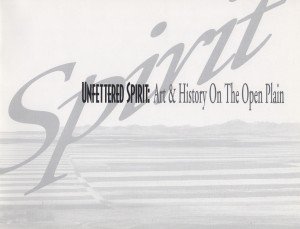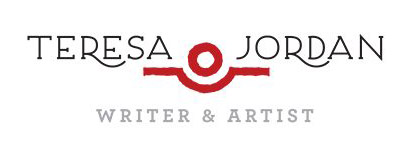The Genius of These States
By Teresa Jordan
 A Foreword for Unfettered Spirit: Art and History on the Open Plain
A Foreword for Unfettered Spirit: Art and History on the Open Plain
Exhibit Catalogue, Paris Gibson Square Museum of Art, 1998
I had just transferred East for my junior year of college when I first heard the quip that Western Art was an oxymoron. I took offense. However sophisticated my new schoolmates might be, they knew nothing about my part of the world; who were they to judge its expressions? I grew up surrounded by reproductions of Charlie Russell paintings and Will James drawings; like many people who worked on the land, my ranching family preferred these artists to Frederick Remington. Remington might have been the better painter, we conceded, but Russell and James knew the world of work, and even more important, they knew the horse. Work and horses: this was the real stuff of our world.
But even as I defended the art of my region, I had a secret. My favorite print was the work of none of these men. In fact, it wasn’t even Western. “The Red Horses” by Franz Marc hung over our love seat, and I could look at it for hours: three horses, luminous with shades of crimson, vermillion and orange; one in motion, another grazing by a craggy, cobalt ledge, and the third looking behind, into infinite distance. The horses were not ‘real,’ the colors were not ‘real,’ even the landscape was not ‘real.’ Yet Marc had captured something that more strongly resonated with my own experience than the hard-muscled accuracy of Russell and the rest. Years later, I would learn that Marc, co-founder with Kandinsky of the Blue Rider group in Germany, turned to animal subjects in his quest for spiritual purity; all I knew at the time — and this was a felt knowledge rather than an articulated one — was that his painting spoke to me. I was said to have a slight gift with horses; the extent to which this was true, I realize now, had much to do with a sensibility I could not have described but found manifest in Marc’s work.
“[T]he landscape may indeed be a text on which generations write their recurring obsessions,” writes Simon Schama in his deep and fascinating ramble through cultural history, Landscape and Memory. He suggests that what we see when we look at nature has everything to do with who we are and where we’ve been — not only as individuals, but as participants in a cultural memory that extends eons into the past, a memory that has been shaped — and continues to be shaped — by myth, experience and history. It is this “inherited tradition” that “makes landscape out of mere geology and vegetation.”
By way of example, Schama cites the Claude-glass, a small hand mirror popular in the 18th Century. It was named after Claude Lorrain (1600-1682), whose elegant landscapes captured an almost ethereal harmony: classical architecture set against a layering of leafy groves or majestic cliffs, gauzy mist and mystical illumination, and almost infinite space. Lorrain’s vision of an idealized harmony was so influential that many artists and tourists carried the glass in order to reflect and frame a landscape that pleased them. “If the view in the mirror approximated to this Claudian ideal, it was judged sufficiently ‘picturesque’ to be appreciated or even drawn….Later versions tinted the glass with the light of a radiant dawn or a roseate sunset.’
Artists work, it is said, so others can see. Good art has the power to change us, to let us see things in a new light. This is the gift of art — until we become so enthralled with a particular vision that no new light can penetrate.
“Why,” wrote Wallace Stegner in 1964, “when so much of our literature (for example, Hemingway) strikes us as dealing with a present which has no past, should western books so often strike us as dealing with a past which has no present?” He referred to literature; he could have said as much about art. If some leading American artists of that period seemed infatuated with the new purely because it was new, many Western artists seemed incapable of moving beyond the visions articulated three and four and five generations removed, expansive landscapes in the mode of Moran and Bierstadt or scenes of wild men and wild horses a la Remington, Russell and the crew.
But a third of a century has passed since Stegner wrote, and both art and literature have changed. Many artists and writers are now striving toward work in which both the present and the past resonate, informing each other rather than working to mutual exclusion. I would argue that this maturity is more pronounced in the West than in the country at large. Cynics might suggest that we had further to go; I like to think we benefit from a particularly Western energy and excitement. Whatever the reasons, Montana — led in part by the dozen artists represented in this show and such writers as William Kittredge, Mary Clearman Blew and James Welch — has been in the forefront of artistic and literary renaissance in the West, laying down the Claude-glass of roseate memory in favor of a clearer view of the past and a confident synthesis with the present. That doesn’t mean that contemporary art has outgrown mythology. One myth evolves into another; the question is whether we work out of the myth of someone else’s time, or of our own.
We talk about artists as gifted. Their gift is the ability to to make sense out of chaos, to “shape into one” the many truths around us. Samuel Taylor Coleridge called this “the esemplastic power.” The artist receives a gift during the act of creation, the struggle with inspiration that results in a work of art. When the artist presents that work to the world, we receive it as a gift. Critic and MacArthur Fellow Lewis Hyde, author of The Gift: Imagination and the Erotic Life of Property, explains:
An artist who wishes to exercise the esemplastic power of the imagination must submit himself to what I have called a “gifted state,” one in which he is able to discern the connections inherent in his materials and give the increase, bring the work to life….
Once an inner gift has been realized, it may be passed along, communicated to the audience. And sometimes this embodied gift — the work — can reproduce the gifted state in the audience that receives it….Sometimes, then, if we are awake, if the artist really was gifted, the work will induce a moment of grace, a communion, a period during which we too know the hidden coherence of our being and feel the fullness of our lives.
I experienced “The Red Horses” as a gift, a way into a knowledge I needed in order to survive and which I found reflected nowhere else. As different as my own world on a Wyoming ranch was from that of the spiritual German, Marc’s work seemed to cut to the very heart of my own experience. Still, I did not receive Marc’s painting in a void; surely I absorbed some part of its power by its very association with the Russells that surrounded it. Marc’s painting captured for me the inner life of horses; Russell’s came out of his own daily work with them. Only now do I marvel at the potential of an art drawn from both sources.
Wallace Stegner was not the first, of course, to scorn the state of the expressive arts in America. “I feel, with dejection and amazement,” wrote Walt Whitman in 1871, “that among our geniuses and talented writers or speakers, few or none have yet really spoken to this people, created a single image-making work for them, or absorb’d the central spirit and the idiosyncrasies which are theirs — and which, thus, in highest ranges, so far remain entirely uncelebrated, unexpress’d….Do you call those gentle little creatures American poets? Do you term that perpetual, pistareen, paste-pot work, American art, American drama, taste, verse? I think I hear, echoed as from some mountaintop afar in the west, the scornful laugh of the Genius of these States.”
Whitman wanted passion and complexity, work that came from the true pulse of the land. The work of Remington and Russell might well have pleased him; certainly they created defining images of their time. But genius is fluid and changing, or should be. Whitman would have been surprised if such images held sway a century later.
I suspect that the bard used the word Genius – with a capital G – in a more classical sense than the contemporary connotation of a person set apart as yet another priest in the cult of celebrity. The ancient Romans considered genius something nascent in each of us, our own creative spirit, what the Greeks called daemon. “This genius,” writes Lewis Hyde, “comes to us at birth. It carries with it the fullness of our undeveloped powers. Those it offers to us as we grow, and we choose whether or not to accept, which means we choose whether or not to labor in its service… to suffer change.
“To suffer change” — it’s an extraordinary phrase, and at the core, I think, of the potential of the works in this exhibition. These are works drawn from a changing West, a West in motion. They have changed the artists as they were brought into being; they have the power to change us if we attend to them. If Whitman were to return to us now, I hope he would find that the Genius of that far western mountain is finding voice. This exhibition presents the work of a dozen artists who have labored in its service, work of the spirit born from work on the land. A gift.
©1998 by Teresa Jordan
